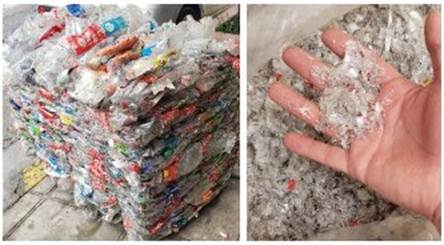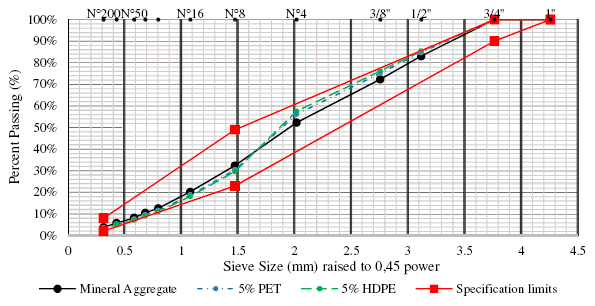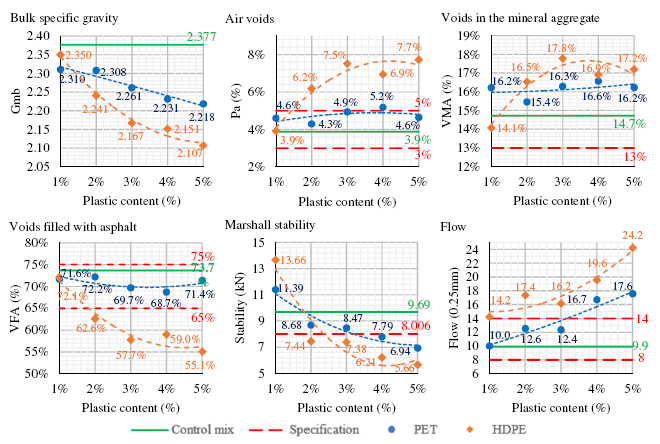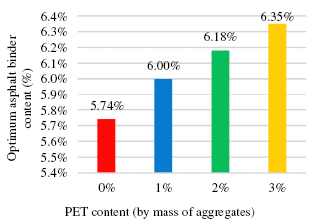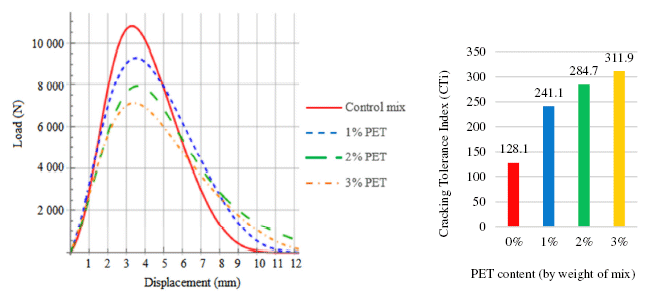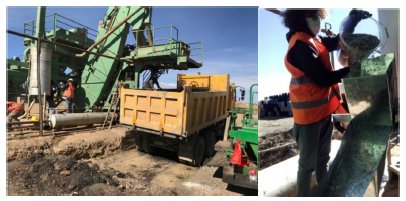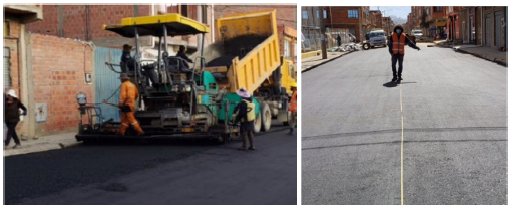1. INTRODUCTION
According to the Bolivian Ministry of Environment and Water, 5 920 tons of waste materials are generated daily in Bolivia, from which plastics represent 15.2% of the total by mass [1]. Even tough almost all plastics can be reused to produce new materials, in Bolivia only 4% of solid waste materials are recycled [2]. Because of that, it is important to develop new construction materials that contain recycled products to reduce the amount of waste sent to landfills.
Many institutions like the Federal Highway Administration (FHWA) in the United States have implemented policies to use waste materials in pavements because of the environmental and performance benefits [3]. Nonetheless, these modified materials must be properly designed to perform as high-quality materials or at least accomplish quality specifications. Therefore, in this study the addition of waste plastics must provide both environmental and performance benefits.
There are two methods to add plastics to asphalt mixes, the wet process and the dry process. In the wet process, the plastic is melted and added to the asphalt binder as a polymer modifier by mechanical mixing; this process uses up to 8% of plastic by weight of binder [4]. In the dry process, the plastic is added to the asphalt mix replacing a part of the aggregates; this often makes it possible to reduce the production costs of the asphalt mix and improve performance [5]. The dry process uses up to 5% of plastic by weight of mixture, about 30 times more plastic than the wet process, providing a greater environmental benefit. Moreover, the equipment required to modify an asphalt binder is not common in Bolivia and its implementation requires greater efforts than the modification of an asphalt plant. Consequently, the dry process was used to add plastics to the asphalt mixture.
The addition of a new material involves several challenges that must be properly addressed. Hence, the first objective of this project focused on the design of an asphalt mix with addition of plastic that accomplishes all the performance specifications. It is also important to delineate the proper procedures for the addition of plastic in the asphalt plant and its handle for the placement of the asphalt layer. It must be verified if through the defined construction process the mix properties are achieved according to the laboratory design. Consequently, a test road was built to properly study the production and placement process.
2. ASPHALT MIX DESIGN
To accomplish all performance requirements of the asphalt mix, an adequate proportion of all materials that make up the asphalt matrix must be defined. When adding a new material, major changes in volumetric properties are expected, therefore, performance tests must be considered for the design of the asphalt mix. In this study, the performance to permanent deformations was analyzed by Marshall stability - flow relationship and the performance to cracking was analyzed by IDEAL-CT tests.
2.1. Design parameters
The design mix must accomplish all minimum requirements according to the test road conditions. These conditions define the parameters for the asphalt mix design, in general, traffic and temperature conditions must be considered [6].
Traffic: The specifications for Marshall mix design require to know the expected traffic level on the design lane over a 20-year period in equivalent axe loads to 8,2 T (ESALs) [7]. According to the project specifications, it is expected a traffic over 1∙106 ESALs, so the asphalt mix was designed for heavy traffic. The following criteria was followed:
Compaction effort: 75 blows per side with Marshall hammer.
Marshall stability: 8 006 N minimum.
Flow: 8 to 14 (0,25 mm).
Air voids (Pa): 3% to 5%.
Voids in the mineral aggregate (VMA): 13% minimum (for 3/4'’ NMAS).
Voids filled with asphalt (VFA) 65% to 75%.
Temperature: the region temperature must be considered to select the asphalt binder, due to the viscoelastic properties of the binder there must not be susceptibility to permanent deformations or fatigue cracking [8]. For this project, unmodified asphalt cement was selected, classified as 85-100 PEN.
2.2. Materials
To proceed with the design of the asphalt mixture, all the properties of the materials that make up the asphalt matrix must be known. Quality control tests were also be conducted on these materials to meet the project specifications.
2.2.1. Waste Plastics
When modifying asphalt mixes or asphalt binders, it is important to carefully control the properties of the modifier, especially if it is a waste material [9]. Considering that plastics would be exposed to different conditions during the production and placement process, the following requirements must be met:
To use the dry process, the melting temperature of the plastic must be higher than the mixing temperature of the asphalt mix [10]. If the plastic melts before mixing with the asphalt binder, it may get adhered to the asphalt plant components and increase the maintenance cost of the machines or, it may even stop the production until cleaning the asphalt. This also ensures that the plastic will not degrade during the production of the asphalt mix, as it can change the composition of the mixture and cause further environmental damage [11].
The plastics to be used for the project must not represent a health risk for plant or field workers [12]. For example, Polyvinyl Chloride (PVC) generates toxic gases when it is exposed to high temperatures, which cannot be avoided during the mixing and compaction processes [13].
For the project purposes, the plastic must be available in sufficient quantities to ensure the production of the asphalt mix. There are plastics as Polypropylene (PP) that met the previous requirements; however, the Municipal Secretariat of Environment Management of La Paz does not collect it because of its limited uses.
According to these requirements, Polyethylene Terephthalate (PET) and High-Density Polyethylene (HDPE) were selected to be used in this project. These plastics were provided by the Municipal Secretariat of Environment Management of La Paz in packages of 100 kg [14]. It is important to note that these plastics are obtained from municipal waste, so they require more treatment than industrial waste [9]. Since the plastics would not be subjected to the high temperatures of the drying process in plant, they must not have a residual liquid content because of the deleterious effects of water on the asphalt mix performance. Likewise, it is important to minimize the content of different plastics other than those selected, that may be present in bottle caps or labels, to avoid the presence of materials not considered in the design [11].
The plastics must be shredded to get the smallest possible particle size. It has been demonstrated that bigger plastic particle sizes generate greater voids contents as well as heterogeneity and segregation problems [5]. Figure 1shows the shredded bottles used in this study, the nominal size of the shredded PET particles was equivalent to the N°4 sieve and HDPE had a nominal size of 3/8’’.
The specific gravity and particle size of plastics must be defined by laboratory tests to properly evaluate the effect of the plastic on the volumetric properties of the asphalt mixture. According to the laboratory tests conducted, the specific gravity of PET is 1,359 and that of HDPE is 0,958.
2.2.2. Mineral Aggregates
The mineral aggregates used in the project were extracted from the Vilaque River in La Paz, and they were crushed in an aggregate processing plant. These materials meet the recommendations of the Asphalt Institute [7] for traffic levels up to 30∙106 ESALs. The gradation resulting of the blend of the different granular fractions meet SUPERPAVE and local specifications.
To evaluate the volumetric properties of the asphalt mixture, the apparent, effective and bulk specific gravity of the mineral aggregate must be considered, which depend on the content of air voids of the aggregate and its capacity to absorb water and asphalt [15]. Note that when adding the plastic using the dry process, a part of the mineral aggregate is replaced by the plastic; therefore, corrections in the specific gravity must be made due to the addition of a new material.
In order to that, the plastic is considered as a new granular fraction in the aggregates blend. Since plastics do not present voids as the mineral aggregates, its bulk specific gravities are considered as equal to its apparent specific gravities, using the value obtained above. A harmonic mean was used to correct specific gravities and a weighted mean to correct the absorption.
The effective specific gravity of the mineral aggregate depends on the absorption of asphalt binder; therefore, it is recommended to obtain its value through the theorical maximum specific gravity test using a mixture with known asphalt content. Because of that, the theorical maximum specific gravity test was conducted for each PET and HDPE content used in the project.
The gradation must be corrected because of the addition of plastic. Usually, the gradation depends only on the mass proportion of each granular fraction; however, because of the low density of plastics, the corrections were made considering the volume of each granular fraction. For this, the equation 1 was used.
where:
The Figure 2 shows the effect of the different plastics used on the gradation curve of the asphalt mix. Even though a small variation is shown on the gradation, these changes are enough to get a more discontinuous curve, increasing the voids content. Mixtures with addition of PET in contents up to 3% or HDPE in contents up to 2% meet all requirements of the Bailey method. Mixtures with higher contents meet the gradation specifications, but according to the Bailey method these mixes are susceptible to segregation or workability problems.
2.2.3. Asphalt cement
To appreciate the effect of plastic in the performance of the asphalt mix, an unmodified asphalt binder classified by penetration has been used. This material was carefully selected according to the project temperature and traffic conditions. Consequently, an asphalt cement classified as 85-100 PEN was selected, according to the conducted laboratory tests this material meets all ASTM D 946 specifications.
Mix and compaction temperatures depend on the asphalt binder properties. These parameters have an especial relevance for this study because the plastics used must have a higher melting temperature. Since an unmodified asphalt binder is being used, the equiviscosity method can be used to define these temperatures [16]. According to this method, the mixing temperature must be between 139°C to 142°C and the compaction temperature between 131°C to 134°C.
2.3. Volumetric properties and Marshall Mix design
To properly analyze the effect of the plastic in the asphalt mix, a conventional mix design must be conducted to be used as a control mix. Therefore, a Marshall mix design was carried out, resulting on an optimum binder content of 5,74%. The properties of this mix are shown in Figure 3.
Once the control mix is defined, specimens with addition of PET and HDPE in contents of 1% to 5% are analyzed. The plastics were added as a percentage of the total mass of the mix and the remaining percentage is the previously designed conventional mix. The plastic addition was done this way because the asphalt plant does not recognize the addition of plastics, therefore the plastic must be added during the conventional production; this also avoids the need of a new calibration to the plant. Notice that this system of addition proportionally reduces the amount of mineral aggregate and asphalt binder, reducing costs.
The mixes with addition of plastic were compacted and tested according to the Marshall procedures. This makes it possible to analyze the effect of the addition of PET and HDPE on the asphalt mix when comparing their properties to those of the control mix. The Figure 3 shows the result of the tests.
The asphalt mixes with addition of PET meet all the quality specifications for conventional mixes when using up to 3% of the plastic; despite, none of the mixes with addition of HDPE meet the requirements. The effect of plastic in the volumetric properties must be analyzed because it is an indicator of the performance of the asphalt mix, and even if specifications are met, some changes may denote an inferior performance. The relationship between stability and flow is useful to analyze the effect of plastic in the performance to permanent deformations.
As stated above, the addition of plastic generates discontinuities in the gradation curve. Therefore, the content of voids in the mineral aggregate (VMA) increased, generating stability problems as shown in mixes with addition of more than 1% of plastic. The increase in the VMA also generates an increase in the mixture air voids which may cause durability problems in the asphalt mix.
The asphalt mix with addition of 1% of PET has a much better stability, increasing 1,7 kN compared to the control mix and the flow is almost constant, varying only by 0,1 units. This can be translated as a better performance to permanent deformations when using 1% of PET. However, greater PET contents are detrimental to the performance of the asphalt mix. The mix with addition of 1% HDPE has increased stability by 3,97 kN, but its flow is 14,2 units and consequently it is susceptible to deformations.
The demand of asphalt binder in the mixture is affected by changes in the volumetric properties [17]. To analyze these changes, another series of Marshall tests were conducted in which the content of asphalt binder was modified, and the content of plastics was kept constant. Mixes with addition of PET up to 3% by the mass of the mineral aggregates were analyzed since performance problems arise with higher plastic contents. An optimum content of asphalt binder is obtained from these tests; Figure 4 presents the results of these tests.
As shown in the figure, the increase on the PET content produces a greater asphalt demand. This can be related to the increase of the air voids content, as bigger amounts of asphalt will be needed to get a 4% of voids required for the design. It also happens because the plastic particles are flat and they have a lower density, so they require more asphalt to cover their surface.
2.4. Evaluation of cracking tolerance
To evaluate the effect of PET in the asphalt mixes, it is important to analyze the performance to cracking of the modified asphalt mix. To do so, IDEAL-CT tests were conducted in mixtures with PET contents up to 3% by mass of mix and the results were compared with the results of the control mix. The tests were conducted according to the recommendations of report 9-57 from the National Cooperative Highway Research Program (NCHRP) [18], using 10,1 cm diameter specimens compacted with a Marshall hammer and tested at 15°C.
The IDEAL-CT test is a compression test in a Lottman load frame, applying a constant vertical deformation of 50 mm/min. From the test, a load vs deformation curve is obtained to calculate the cracking tolerance index (CTi) [19]. Therefore, the CTi does not only depend on the maximum load applied but also from the fracture energy and the slope developed during the fracture propagation. The following Equations (2) and (3) are used.
where:
𝐺𝑓 = Fracture energy.
(𝑙) = Function of the load respect to the vertical deformation.
𝑡 = Specimen thickness.
𝐷 = Specimen diameter.
For the test, an exponential function was adjusted to the observed load-deformation points, obtaining a determination coefficient over 0,999. Results are shown in Figure 5.
The maximum load developed during the test is reduced when adding PET, however, the CTi increases by 88,2% with respect to the control mix when adding 1% PET, and it continues to increase when adding PET in contents up to 3%. This happens because the value of the slope m75 decreases when adding PET and the fracture energy remains constant. Therefore, the addition of PET to the asphalt mix improves the performance ton fatigue cracking, providing a resilient mix that avoids the cracking propagation.
According to IDEAL-CT and Marshall tests, the addition of 1% PET to the asphalt mix improves the performance to fatigue cracking and permanent deformations, and it meets all the specifications for volumetric properties. Hence, it was selected as design mix to be reproduced in plant.
3. PRODUCTION OF ASPHALT MIX WITH ADDITION OF PLASTIC
The design mix must be produced within an asphalt plant, reproducing the proportion of the materials and the temperatures specified in the design. It is necessary to understand all the operations that are performed in the asphalt plant to define the adequate procedure to add the PET. For this study, a continuous asphalt plant that has a maximum production of 60 T/h was modified to produce the design mix.
PET must be added in the asphalt plant avoiding its exposure to excessive temperatures and it must not pass thorough the aggregate weighting systems after the feeding system as it may require a complete calibration of the asphalt plant. Although the aggregates achieve the mixing temperature after passing through the dryer drum, the temperature inside the dryer is higher than 200 °C and the material may even get in touch with the burner flame, therefore the PET must be added after the dryer drum section. There are gates on the hot bins where PET can be added, however, it may require an additional calibration, and the material may be expelled from the plant with the oversized aggregates because of the flat particles and low density of PET. Therefore, PET was added through a gate in the bucket elevator that transports mineral aggregates from the hot bins to the mixer. The Figure 6 shows the addition of plastic to the asphalt plant.
As PET is added through the bucket elevator, it might not be recognized by the asphalt plant command console; then the plant must be operated at the lowest production rate of 26,8 T/h. According to this value, the rate of PET addition was defined on 4,5 kg/min of plastic.
After the mix was produced in plant, quality control tests must be conducted. According to these tests outcomes, the asphalt mix has been adequately reproduced, obtaining acceptable results according to local specifications. A resume of the results is shown in TABLE 1.
TABLE 1 DESIGN AND PANT ASPHALT MIX PROPPERTIES
| Mix | Loose mix | Compacted mix (75 blows with Marshall Hammer) | ||||||
|---|---|---|---|---|---|---|---|---|
| Asphalt content (%) | Theorical maximum specific gravity (Gmm) | Bulk specific gravity (Gmb) | Content of air voids Pa (%) | Voids in the mineral aggregate VMA (%) | Voids filled with asphalt VFA (%) | Marshall Stability (N) | Flow (0,25 mm) | |
| Design | 5,68 | 2,422 | 2,310 | 4,6 | 16,2 | 71,6 | 11 394 | 10,0 |
| Plant | 5,77 | 2,428 | 2,323 | 4,3 | 15,8 | 72,8 | 11 956 | 10,7 |
4. CONSTRUCTION OF TEST ROAD
The produced asphalt mix was placed in a test road in the east lane of Tarata Avenue in El Alto. This section is 15 m long and 4 m wide, corresponding to the half of the total width of the avenue, and it has a thickness of 6 cm. The construction of the test road is shown in Figure 7.
No adjustments were made in the placement and compaction process since the workability of the asphalt mix with addition of PET is similar to the workability of the conventional mix. This resulted in 93,7% compaction with respect to the theorical maximum specific gravity according to the extracted cores, The surface meets all expectations.
81,1 kg of PET were used to build this test road. To obtain that amount of PET, 3 300 PET bottles of 600 ml were recycled. It is possible to use up to 3% of PET, meeting all specifications and triplicating the environmental benefits.
5. ENVIRONMENTAL AND ECONOMICAL BENEFITS
According to the Bolivian Ministry of Environment and Water [20] and the National Institute of Statistics, 16 092 T of PET waste were sent to landfill in 2021 and only the 4% is recycled [21]. For 1% PET addition, it would be required 1,609∙106 T of hot mix asphalt. All that amount of mixture would be used in only 1 216 km of road with a typical section of 2 lanes of 3,6 m wide each and shoulders of 0,6 m with a thickness of 7 cm. According to the laboratory tests, it is possible to use up to 3% PET in asphalt mixtures; therefore, the execution of a 405 km road would reuse all PET waste generated in the country each year.
The Bolivian Roads Administrator (ABC) has built up to 907 km of road in 2019 with even greater typical sections [22]. These quantities do not consider maintenance projects or municipal and private projects. In this way, it is possible to remark the great environmental benefits that this type of mixtures could provide. If these asphalt mixes are implemented in the country, it is possible to reuse all the PET waste from major cities.
In Bolivia, high investments are being made for the construction and maintenance of roads. The ABC had an annual budget of 1 065.99 million dollars in 2019 [22]. Asphalt mixes with addition of PET would not significantly increase the production costs. The costs analysis made for this project shows that the addition of 1% PET to the asphalt mix does not have a significant economic effect, reducing the costs by only 0,08%. However, PET must be processed to obtain a small particle size and to remove deleterious materials like other plastics or moisture content; this increases the cost of the asphalt mix. A 3% PET addition increases the cost by 1,76%. These economic effects are relevant during the construction process; nonetheless, it is important to consider that a better performance will lengthen the life of the pavements reducing maintenance costs. Additionally, the usage of great amounts of waste materials reduces the municipal space used as landfill and recovers the value of the material.
6. CONCLUSIONS
The addition of waste plastics to asphalt mixes by the dry process makes it possible to recycle great amounts of waste plastics and enhances the performance of the asphalt mix. According to the laboratory tests, the addition of 1% PET improved the performance of the asphalt mix as it increased the stability by 17,5% with respect to the control mix and the flow remained constant; likewise, the cracking tolerance index was increased by 88,2%. PET contents up to 3% increased the CTi up to 143% with respect to the control mix, however, the stability is decreased when adding PET in contents higher than 1% and therefore the performance to permanent deformation might be affected. The asphalt mixes with addition of HDPE shown insufficient performance as they did not meet the Marshall specifications; this is related to the greater impact on volumetric properties.
The production and placement process of the asphalt mix used in this project allowed to adequately achieve all the specified requirements for quality control. The addition of PET to the asphalt plant did not represent operational complications and no major modifications were made. It is necessary to emphasize that the plastic must be added in a section after the dryer drum because of the excessive temperatures developed in the drying process and the problems that the melting or degradation of plastic can cause. This process can be easily replicated at other asphalt plants, and automatic feeding systems can be added through modifications to the control panels. The asphalt mix produced has a similar workability to a conventional mix; therefore, it is not necessary to modify the construction process to obtain a high-quality asphalt layer.
It is estimated that for each 10 m of paved lane with 7 cm of thickness, 7 000 PET bottles of 500 ml can be reused. These asphalt mixes have a high performance, and therefore can extend the useful life of the pavement, generating economic benefits. Because of that, it is important to encourage the usage of waste materials in the country’s road infrastructure.













